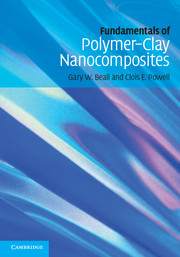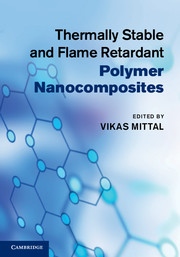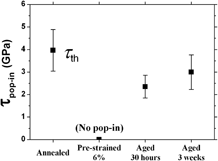Refine search
Actions for selected content:
106100 results in Materials Science
In situ thermomechanical testing for micro/nanomaterials
-
- Journal:
- MRS Communications / Volume 1 / Issue 1 / November 2011
- Published online by Cambridge University Press:
- 12 August 2011, pp. 13-16
- Print publication:
- November 2011
-
- Article
- Export citation
Relationship between yield point phenomena and the nanoindentation pop-in behavior of steel
-
- Journal:
- Journal of Materials Research / Volume 27 / Issue 1 / 14 January 2012
- Published online by Cambridge University Press:
- 11 August 2011, pp. 39-44
- Print publication:
- 14 January 2012
-
- Article
- Export citation
Interfacial delamination cracking shapes and stress states during wedge indentation in a soft-film-on-hard-substrate system—Computational simulation and experimental studies
-
- Journal:
- Journal of Materials Research / Volume 26 / Issue 19 / 14 October 2011
- Published online by Cambridge University Press:
- 11 August 2011, pp. 2511-2523
- Print publication:
- 14 October 2011
-
- Article
- Export citation
Interdiffusion and the vacancy wind effect in Ni–Pt and Co–Pt systems
-
- Journal:
- Journal of Materials Research / Volume 26 / Issue 18 / 28 September 2011
- Published online by Cambridge University Press:
- 11 August 2011, pp. 2384-2393
- Print publication:
- 28 September 2011
-
- Article
- Export citation
Biomolecular sensing using gold nanoparticle–coated ZnO nanotetrapods
-
- Journal:
- Journal of Materials Research / Volume 26 / Issue 17 / 14 September 2011
- Published online by Cambridge University Press:
- 11 August 2011, pp. 2328-2333
- Print publication:
- 14 September 2011
-
- Article
- Export citation
Preparation of porous zirconium microspheres by magnesiothermic reduction and their microstructural characteristics
-
- Journal:
- Journal of Materials Research / Volume 26 / Issue 16 / 28 August 2011
- Published online by Cambridge University Press:
- 09 August 2011, pp. 2117-2122
- Print publication:
- 28 August 2011
-
- Article
- Export citation

Fundamentals of Polymer-Clay Nanocomposites
-
- Published online:
- 05 August 2011
- Print publication:
- 07 July 2011

Thermally Stable and Flame Retardant Polymer Nanocomposites
-
- Published online:
- 05 August 2011
- Print publication:
- 30 June 2011
Meltspun Ba8Ga16−xGe30+x clathrates
-
- Journal:
- Journal of Materials Research / Volume 26 / Issue 15 / 14 August 2011
- Published online by Cambridge University Press:
- 05 August 2011, pp. 1861-1865
- Print publication:
- 14 August 2011
-
- Article
- Export citation
Microstructures and nanostructures in long-term annealed AgPb18SbTe20 (LAST-18) compounds and their influence on the thermoelectric properties
-
- Journal:
- Journal of Materials Research / Volume 26 / Issue 15 / 14 August 2011
- Published online by Cambridge University Press:
- 05 August 2011, pp. 1800-1812
- Print publication:
- 14 August 2011
-
- Article
- Export citation
JMR volume 26 issue 15 Cover and Back matter
-
- Journal:
- Journal of Materials Research / Volume 26 / Issue 15 / 14 August 2011
- Published online by Cambridge University Press:
- 05 August 2011, pp. b1-b5
- Print publication:
- 14 August 2011
-
- Article
-
- You have access
- Export citation
Maximum performance in self-compatible thermoelectric elements
-
- Journal:
- Journal of Materials Research / Volume 26 / Issue 15 / 14 August 2011
- Published online by Cambridge University Press:
- 05 August 2011, pp. 1933-1939
- Print publication:
- 14 August 2011
-
- Article
- Export citation
JMR volume 26 issue 15 Cover and Front matter
-
- Journal:
- Journal of Materials Research / Volume 26 / Issue 15 / 14 August 2011
- Published online by Cambridge University Press:
- 05 August 2011, pp. f1-f7
- Print publication:
- 14 August 2011
-
- Article
-
- You have access
- Export citation
Energy Focus: Lithiation highway in Si nanopillars contributes to anisotropic shape changes
-
- Journal:
- MRS Bulletin / Volume 36 / Issue 8 / August 2011
- Published online by Cambridge University Press:
- 16 August 2011, pp. 576-578
- Print publication:
- August 2011
-
- Article
-
- You have access
- HTML
- Export citation
High-field properties of pure and doped MgB2 and Fe-based superconductors
-
- Journal:
- MRS Bulletin / Volume 36 / Issue 8 / August 2011
- Published online by Cambridge University Press:
- 16 August 2011, pp. 626-630
- Print publication:
- August 2011
-
- Article
- Export citation
Japan seeks to expedite commercialization of printed electronics: www.meti.go.jp
-
- Journal:
- MRS Bulletin / Volume 36 / Issue 8 / August 2011
- Published online by Cambridge University Press:
- 16 August 2011, p. 585
- Print publication:
- August 2011
-
- Article
-
- You have access
- HTML
- Export citation
IUMRS seeks nominees for 2012 Sōmiya Award: www.mrs.org/mrc
-
- Journal:
- MRS Bulletin / Volume 36 / Issue 8 / August 2011
- Published online by Cambridge University Press:
- 16 August 2011, p. 657
- Print publication:
- August 2011
-
- Article
-
- You have access
- HTML
- Export citation
NIST selects first Chief Manufacturing Officer: www.nist.gov
-
- Journal:
- MRS Bulletin / Volume 36 / Issue 8 / August 2011
- Published online by Cambridge University Press:
- 16 August 2011, p. 585
- Print publication:
- August 2011
-
- Article
-
- You have access
- HTML
- Export citation
The influence of in situ formed precipitates on the plasticity of Fe–Nb–B–Cu bulk metallic glasses
-
- Journal:
- Journal of Materials Research / Volume 26 / Issue 16 / 28 August 2011
- Published online by Cambridge University Press:
- 01 August 2011, pp. 2080-2086
- Print publication:
- 28 August 2011
-
- Article
- Export citation
Proposed revised Bylaws and Articles of Incorporation: www.mrs.org/elections
-
- Journal:
- MRS Bulletin / Volume 36 / Issue 8 / August 2011
- Published online by Cambridge University Press:
- 16 August 2011, pp. 640-645
- Print publication:
- August 2011
-
- Article
-
- You have access
- HTML
- Export citation











